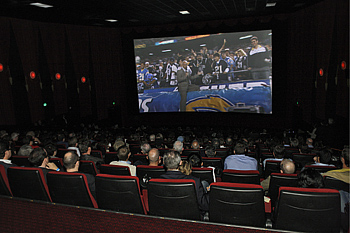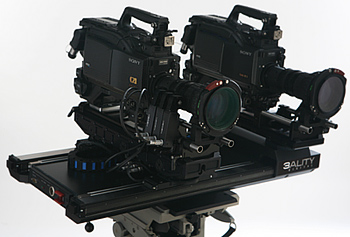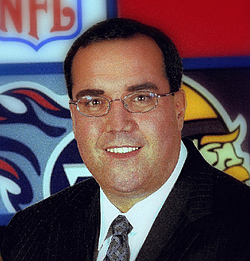NFL Enters a New Dimension
MT. LAUREL, N.J. Last month, the NFL offered a VIP audience in three digital cinemas in Boston, Los Angeles and New York, the first-ever live 3D HD broadcast of an NFL football game—between the San Diego Chargers and Oakland Raiders—and a sneak peak at what many predict is the future of television.
In the same way that HDTV gave sports fans at home the perspective of the best seat in the house, 3D HD goes a step further, giving viewers the sensation of being virtually on the field and in the midst of game action.

In addition to theatres in Boston and New York, the live 3D HD NFL game was also shown in Mann's Chinese Theatre in Hollywood. "You really do feel like you're down on the field, and watching the players run right into your living room. It was a magical experience watching this game in 3D HD," said Glenn Adamo, vice president, production and media operations for the National Football League.
Adamo said the event was primarily a test designed to enable the league to better understand the optimal way to cover live football in 3D HD.
"We think it was a terrific success in that we learned how beautifully the game translates into three dimensions," he said.
FORMAT WITH A FUTURE
While this experimental presentation was delivered via satellite to three digital cinemas, the key players involved—3ality Digital and RealD, two Los Angeles-based facilities specializing in 3D HD, along with the NFL—all agreed that this 3D HD technology could become "the new normal" of television viewing, trumping HDTV in a few years. This upgrade to the TV viewing experience will depend on cooperation by consumer electronics manufacturers, broadcasters, and industry standards bodies.
Because the Chargers/Raiders game was also carried live (from Qualcomm Stadium in San Diego) on the NFL Network, this made it easier for the NFL and the NFL Network to coordinate production logistics for two side-by-side telecasts—HDTV and 3D HD—with 5.1 surround sound.
The 3D HD show was produced by 3ality Digital, which provided specialized 3D HD cameras. Several of the Emmy-award winning cinematographers from NFL Films operated these 3D HD cameras, which Adamo said helped maintain a consistent NFL Films production style.
PRODUCTION FLEXIBILITY

3ality Digital's new TS4 side-by-side lightweight camera rig, outfitted with Sony cameras, was among the camera setups used to cover the event. 3ality Digital employed two types of 3D HD cameras—side-by-side and beam splitters—which they designed and built expressly for 3D HD production using off-the-shelf HD camera equipment from Sony, including the Sony 1500 and F950 models, as well as one rig based on the Cunima MCU1 HD camera, an ultra-compact HD camera developed by Wige Media A.G. in Germany.
With five side-by-side cameras and three beam splitter camera rigs—arranged around the field, end zones, announce booth, and on sideline carts—Director Bob Levy and Producer Steve Beim had the creative flexibility to get the shots they wanted and make the show much more dynamic.
"If you're trying to capture action that's 20 feet or more away from the camera, you're typically going to want to use the side-by-side rig," said Howard Postley, chief operating officer and chief technology officer for 3ality Digital. "But for action that's closer than 20 feet to the camera, you're going to want the flexibility of the beam splitter camera."
MIRROR IMAGES
Like the name implies, the side-by-side camera rig has two HD cameras positioned right next to each other. However, Postley said, "Unless you're working with very small cameras and lenses, you can't get them close enough to shoot a shot closer than 10 to 15 feet."
The beam splitter's two cameras are positioned perpendicular to each other, with one shooting straight out and one pointed up or down at the other camera. Both are shooting at a beam splitter, with a very expensive mirror, so both images get reflected through the same mirror. This enables both lenses to overlap more closely than is possible with the side-by-side camera.
The lenses were Fujinon 22:1 ENG HD telephoto lenses. Larger box lenses, such as the 100:1 and 88:1 types common in live sports, were not used because the image stabilization systems in these lenses treat each lens independently. "Because they don't stabilize the two lenses in precisely the same way at the same time, this causes a sort of 'wave effect' which you'd never see in 2D, but in 3D it's very pronounced and it drives our image processors nuts," Postley said.
"Perfect mechanical and optical alignment is the key to watching a 3D HD program without eye strain," Postley added. "And perfect alignment is also the key to overlaying graphics on the 3D HD video."
TECHNICAL CHALLENGES

Glenn Adamo, vice president, media operations for the National Football League. Graphics, such as player statistics, the game clock and score box, were used during the game, and the director had fun experimenting with their placement—having them either jump out at the viewers or recede in the background. However, 3D versions of the first and ten line and distance-to-go graphics that are superimposed on the field were not used because of the complexity involved with pulling these illusions off credibly. Postley said that by mid-summer 2009, they hope to have an image processor that can handle real-time compositing of 3D HD and remedy the problems of superimposed graphics.
"We faced lots of technical challenges because there were lots of things in this broadcast that had never been done before," Postley said. 3ality Digital also employed a lot of new equipment, including new rigs, coordination software, image processor packaging, and fiber systems.
Alibaster, Ala.-based Crosscreek Television's Voyager 8 HD production truck was used for the event. The truck is outfitted with 38 channels of EVS, as well as 12 Sony HD cameras, designed to cater to high-profile sports telecasts by ESPN, CBS, and others.
3ality Digital placed a stereoscopic 3D monitor on the truck so that the director could preview what was being broadcast in 3D HD (while wearing specialized RealD 3D glasses). They also added an image processor box that plugged in outside the truck to deal with the camera feeds, and provided a stereographer and several convergence operators to handle the 3D HD image processing.
The 3D HD signal was then compressed to 20 Mbps and transmitted via satellite by Technicolor Digital Cinema to the three theaters in Boston, Los Angeles, and New York, which are run by Clearview Cinemas, Mann Theaters and National Amusements respectively.
GETTING RealD
RealD provided the delivery platform, including 3D HD projection hardware, software, and comfortable, polarized 3D eyewear used in digital cinemas. RealD has licensed its 3D HD digital cinema technology to more than 100 exhibitors in 30 countries, and over the last three years, expanded to 6,500 screens under contract. RealD now has more than 90-percent of the 3D HD digital cinema market.
"At this NFL event, we wanted to demonstrate that there is an opportunity here… beyond movies… to show live sports and concerts… and that the technology has gotten extremely good," said Michael V. Lewis, chairman, chief executive officer, and co-founder of RealD.
"In the lobbies of the three theaters, we had 3D HDTVs that were using our technology to show the event so that people [wearing the glasses] could continue watching as they got their food and drinks," Lewis said. "So we just demonstrated that we have this solution to make it happen in the home." A small percentage of HDTVs by leading consumer electronics manufacturers already support 3D HD display.
FOX SPORTS SHOW AT CES
3ality and RealD is also demonstrating this capability at CES 2009 this week in Las Vegas. At CES, RealD will present the BCS college football championship game (between the University of Florida and University of Oklahoma in Miami) being produced by Fox Sports on January 8, 2009. The live game will be seen in 3D HD in the 2,000-seat RealD equipped digital cinema within the Paris Las Vegas hotel.
"At some point, every type of display device, including handhelds, laptops, and HDTVs, will support 3D HD viewing," Lewis said. "And we believe that we're about three to five years away from getting standards established and having 3D HD become available in a significant way in the home."
Get the TV Tech Newsletter
The professional video industry's #1 source for news, trends and product and tech information. Sign up below.

